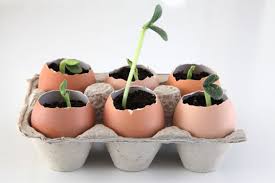 There are about 298,000 species of plants. Some of them we find useful or tasty. We let them grow where they are easy to harvest. Some fruits can be harvested for decades from the same tree, we need to sow some vegetables annually. We sometimes eat the fruit, sometimes the seeds (sometimes the flower (artichoke), root (parsnip), the stem (celery), leaves (spinach),...
There are about 298,000 species of plants. Some of them we find useful or tasty. We let them grow where they are easy to harvest. Some fruits can be harvested for decades from the same tree, we need to sow some vegetables annually. We sometimes eat the fruit, sometimes the seeds (sometimes the flower (artichoke), root (parsnip), the stem (celery), leaves (spinach),...
Plants are divided into different groups, species, families. We do not go into that.
In a monocot (monocotyledons) the stem grows like a whip from which leaves unfurl itself, from the ground such as grass, onion, corn, hosta, lily, iris..
Most plants are (two) dicotyledonous (dicots). The seed germinates with two opposing bud leaves on a stem that then makes more and more leaves and shoots.
Plant propagation can occur in two ways:
vegetatively or asexually by a particle of a plant to grow into a completely new identical mature plant again.
generative or sexual, by growing fertilized seeds. This provides a plant that combines characteristics from the father (pollen) and mother (the egg in the ovary).
Those male and female parts can occur on the same plant and can grow even in one flower. In this case we call the plant hermaphroditic. Of all plant species is 94% hermaphroditic (bisexual).
Tomatoes, peppers, peppers, etc. are self-pollinating and bisexual examples we usually grow here in the greenhouse. The pollen must only land a few millimeters further on the pistil. A gust of wind, or a tap on the plant are sufficient for this.
In addition there are unisexual plants that only have either male or female flowers.
In monoecious are both male and female flowers on one same plant. E.g. at the zucchini the male flower has pollen and the female a pestle and an ovary (bullet under the flower). Without fertilization there won’t grows a full zucchini.
In corn is the plume on top of the plant male. The female flower is the still immature corncob containing the strings that need to be fertilized.
In dioecious live male and female flowers each on another plant. A LAT relationship. To grow and harvest fertile seeds you need so at least two (preferably more) plants.
Examples are the holly, kiwi, walnut, some species of palm and fruit varieties. By breeding are developed always more self-pollinating varieties.
Many plants live in symbiosis with fungi and bacteria that we (still) do not know or see. Sepp Holzer finds it a good idea to take when moving or seeding plants in their cooperation with the crop and also earth around the mother plant, so that (if any) fungi and bacteria can continue the cooperation with the dislocated specimen. He calls this ground: mother earth.
Plants form their by wind and gravity to spread seeds as high as possible, on top of a stalk. This increases the chance to travel further and colonize and survive.
After seed formation much one and biennial plants die (borage (Borago officinalis), hemp (Cannabis sativa var. indica), carline thistle (Carlina vulgaris), Forget- Me-Not (Myosotis sylvatica), Ragwort (Jacobaea vulgaris), hogweed (Heracleum sphondylium), petty spurge (Euphorbia peplus), leeks, angelica (Angelica archangelica)...) (Annual, biennial, and perennial) plants that die after a single flowering are called monocarpic.
